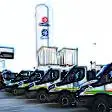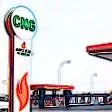
Hydrogen Stations in Switzerland

Table of Hydrogen Stations in Switzerland
| DEALER | ADDRESS | CITY |
|---|---|---|
| COOP | Gewerbestrasse 1 | Hunzenschwil |
| AVIA | Oberstrasse 137 | St. Gallen |
| AGROLA | Bleicheweg 6 | Zofingen |
| AGROLA | Stationsstrasse 82 | Rothenburg |
| AVIA | Riedgrabenstrasse 26 | Rümlang |
| COOP | Chemin de Saugy 3 | Crissier |
| AVIA | Schäracher 2 | Geuensee |
| COOP | Eymattstrasse 15 | Bern |
| COOP | Ringstrasse 31 | Chur |
| COOP | Rheinstrasse 113D | Frenkendorf |
| Schwab-Guillod | Lagerhausstrasse 7 | Müntschemier |
| AVIA | Route sous-la-Ville 2 | Puidoux |
| AVIA | Muttenzerstr. 139 | Pratteln |
| AVIA | Industriestrasse 149 | Gossau |
| AVIA | Schlachthofstrasse 12 | St. Gallen |
| AGROLA | Schürmatt 3 | Schötz |
| SOCAR | A1 Grauholz-Süd | Ittigen |
| For more hydrogen stations click below on the list or the map. |
Map of Hydrogen Stations in Switzerland
List of Hydrogen Stations in Switzerland
Network of hydrogen stations in Switzerland
The transition to cleaner and more sustainable energy sources is a global priority, and Switzerland is no exception. In this context, hydrogen is emerging as a promising alternative for mobility and carbon reduction. This article explores the evolution of the hydrogen station network in Switzerland since 2015 and provides forecasts up to 2025.
Initial Situation and Developments since 2015
The first hydrogen station in Switzerland opened in 2016, marking the start of a new era in the country's alternative fuels infrastructure. This initial milestone was part of a concerted effort to encourage the use of hydrogen vehicles, known for their low emissions and high energy efficiency.
Since then, the network of hydrogen stations has been growing steadily. By 2018, Switzerland had five operational stations, strategically located in key urban areas and transport corridors. By 2020, the number of stations had doubled, with new installations in cities such as Zurich, Geneva and Basel, as well as on major transport routes connecting these urban centres.
The network's growth has been driven by partnerships between the Swiss government, private companies and international organisations. These players have invested significantly in infrastructure and technology, recognising the potential of hydrogen to transform the transport sector and contribute to the country's sustainability goals.
Current locations and planned new openings
Current hydrogen stations are mainly located in the following places:
- Zurich: Various locations in and around the city, including the station on the A1 motorway.
- Geneva: Stations in the city and at Geneva airport.
- Basel: Facilities near the port and on trade routes.
- Berne: Stations in the capital and on the main motorways connecting it to other cities.
- Lucerne: Stations in the city centre and industrial areas.
New stations are expected to open in the following locations by 2025:
- Lugano: Projects under development for stations in southern Switzerland, improving connectivity with Italy.
- St. Gallen: Stations planned to facilitate transport in the north-east of the country.
- Fribourg: New stations in the area to support regional and long-distance transport.
- Fribourg: New stations in the area to support regional and long-distance transport.
- Lausanne: Expansion of hydrogen infrastructure in the Lake Geneva region.
- Lausanne: Expansion of hydrogen infrastructure in the Lake Geneva region.
- Valais: Projects underway for stations in Alpine areas, taking advantage of local renewable energy sources.
Forecasts for 2025
Looking ahead to 2025, the forecasts for the hydrogen station network in Switzerland are optimistic. The number of stations is expected to double again, reaching approximately 30 operational facilities. This growth will be supported by favourable government policies, incentives for hydrogen vehicle adoption and increased interest from private industry.
In addition, an expansion in green hydrogen production capacity is anticipated, with large-scale projects under development that will take advantage of the abundant availability of renewable resources in Switzerland. Cross-border collaboration will also play a crucial role, with Switzerland working together with neighbouring countries to create a Europe-wide network of interconnected hydrogen stations.
Another relevant aspect is the advancement in hydrogen storage and distribution technology, which will allow for greater efficiency and lower operating costs. These innovations are essential to make hydrogen a viable and competitive option compared to fossil fuels and other clean energy alternatives.
Operators with the Most Hydrogen Stations in Switzerland
Below are the operators with the largest number of open hydrogen stations in Switzerland, as well as their expansion plans for 2025:
- Hydrogen Mobility Switzerland: A consortium of companies leading the expansion of hydrogen infrastructure.
- Alpiq: A Swiss energy company that is investing in the production and distribution of green hydrogen.
- H2 Energy: A company dedicated to the development of hydrogen solutions for transport and industry.
These operators play a crucial role in the implementation and operation of hydrogen refuelling stations in the country.
Challenges and Future of Hydrogen in Switzerland
The network of hydrogen stations in Switzerland has come a long way since its inception in 2016, demonstrating significant growth and a clear commitment to sustainability and innovation. Looking ahead to 2025, the outlook is encouraging, with expansion plans and technological improvements promising to consolidate hydrogen as a key pillar of sustainable mobility in Switzerland.






